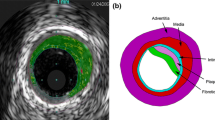Abstract
Realistic simulation of a stent in service loading is necessary for the design of Nitinol stents. This type of analysis is complicated by several issues: artery geometry and material properties are largely unknown and may vary from person to person; the loading on the stent is due to interactions between pulsatile blood flow, the artery, and stent. This study addresses the first issue by obtaining realistic artery geometry from magnetic resonance imaging (MRI) scans of a patient in the fetal and supine positions, and comparing deformation of the stent deployed into the two different artery configurations. The second issue is addressed by investigating two different methods of applying service loading. The first method applies sinusoidal pressure waves directly to the artery wall. The second method considers the effect of blood flow within the artery by performing a fluid-structure interaction (FSI) simulation. Simulation of expansion, annealing, crimping, and deployment of a Nitinol stent into the two artery configurations was performed using Abaqus. Following the deployment, sinusoidal pressure pulses, emulating systolic and diastolic blood pressures, were applied to the inner surface of the artery. To simulate the effect of blood within the artery, the coupled Eulerian-Lagrangian method in Abaqus was used. The blood was modeled as a partially filled Eulerian domain, whose material boundary contacted the Lagrangian artery. Transient inlet velocity and outlet pressure conditions were applied to the Eulerian domain to simulate blood flow. Since fatigue life calculations are important for the design of Nitinol stents, the maximum principal strains at the diastolic pressure troughs and the difference between the maximum principal strains at diastolic and systolic pressure were investigated for five cycles. Different maximum principal strains resulted for the different artery geometries (fetal or supine), while the difference between maximum principal strains was similar. For the simulations including the effect of blood flow, the maximum principal strains at the diastolic pressure troughs were somewhat higher than the simulations in which pressure was directly applied to the artery. In conclusion, this study established and compared various methods of improving the service loading in the simulation of Nitinol stents, specifically including anatomically correct artery geometry and the effect of blood flow.










Similar content being viewed by others
References
N. Rebelo, M. Perry, Finite element analysis for the design of Nitinol medical devices, Min. Invas. Ther. & Allied Technol., 9, 2000, 75–80
N. Rebelo, S. Prabhu, C. Feezor, and A. Denison, Deployment of a Self-Expanding Stent in an Artery, Proceedings of the International Conference on Shape Memory and Superelastic Technologies (Kurhaus Baden-Baden, Baden-Baden, Germany), 2004
RESIStent Program: SRI International, Stanford University and a Consortium of Stent Manufacturers, 2004-2006, private communication
F. Auricchio, R. Taylor, Shape-memory alloys: modeling and numerical simulations of the finite-strain superelastic behavior, Comput. Methods. Appl. Mech. Engng., 143, 1996, 175–94
F. Auricchio, R. Taylor, Shape-memory alloys: macromodeling and numerical simulations of the superelastic behavior, Comput. Methods. Appl. Mech. Engng., 146, 1997, 281–312
E.M. Tittelbaugh, R. Fu, and S. Sett, Coupling FEA to CFD to Investigate the Effects of Pulsatile Blood Flow on the Dilatation of Artery Walls, Proceedings of the NAFEMS World Congress (Vancouver, BC, Canada), 2007
Dassault Systemes SIMULIA Corp., Abaqus User’s Manual 6.8, Providence, Rhode Island, 2008
D. Steinman, B. Vinh, C. Ethier, M. Ojha, R. Cobbold, and K. Johnston, A numerical simulation of flow in a two-dimensional end-to-side anastomosis model, J. Biomed. Eng.115, 1993, 112–8
Author information
Authors and Affiliations
Corresponding author
Additional information
This article is an invited paper selected from presentations at Shape Memory and Superelastic Technologies 2008, held September 21-25, 2008, in Stressa, Italy, and has been expanded from the original presentation.
Rights and permissions
About this article
Cite this article
Rebelo, N., Fu, R. & Lawrenchuk, M. Study of a Nitinol Stent Deployed into Anatomically Accurate Artery Geometry and Subjected to Realistic Service Loading. J. of Materi Eng and Perform 18, 655–663 (2009). https://doi.org/10.1007/s11665-009-9375-0
Received:
Revised:
Accepted:
Published:
Issue Date:
DOI: https://doi.org/10.1007/s11665-009-9375-0




